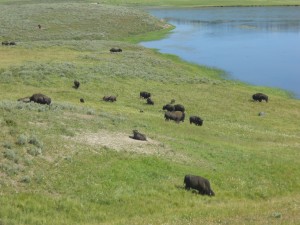
Bison scattered along the landscape of Yellowstone National Park. Photo courtesy of Madeline Hirshan.
Climate change is a very current and pressing issue that is likely to have severe implications such as rising sea levels and increased extreme weather events. Humans are likely to be affected by these changes as will other animals that roam the Earth. Wildlife rely so heavily on the environment that is destined to be altered by impending climate change. They have specific needs for resources, such as food and shelter that only their environment can provide. Wildlife depend on certain temperature cues or ranges for normal life processes such as laying eggs and migrating. Global warming could possibly alter these “cues,” as well as present other challenges like changes in home ranges and mating patterns, and forest depletion due to heat stresses. Scientists are working to uncover how wildlife are responding to these environmental changes in current warming, as well as making projections about effects of increased future warming.
To fully understand the extent of these possible implications, scientists are currently investigating climate change’s impact on wildlife within National parks and protected lands. Recognizing that protected species are at risk and determining what these risks could encompass will be important for understanding the vulnerability of certain species. National parks in the United States were created to protect America’s natural scenery as well as unique habitats and environments. Wildlife that reside within National parks represent a large variety of species including bears and moose in Yellowstone National Park as well as alligators in the Everglades. But living within the bounds of these protected areas does not ensure immunity to the current and coming threats of climate change.
The unknown future of climate change makes it especially important for researches to investigate wildlife responses using projections and models. Current research on wildlife responses to climate change may provide useful information for establishing plans and solutions for the future. Examples of this research include wildlife monitoring in the field and simulated studies of wildlife responses to warming temperatures. Changes in home range dynamics may alter National park’s ability to protect its wildlife as park boundaries are well defined. Many range changes have already been observed and scientists are continually using models to observe wildlife range changes with different climate patterns as well as monitoring wildlife distributions. Interestingly, there is a large amount of literature on specific wildlife species in National parks, their roles in the ecosystem, and likely impacts resulting from a changing climate. One study examined the effect of warming on two mouse species in Yosemite National park to compare the distributions of a generalist with a specialist. Other studies of wildlife in National parks such as Yellowstone and Rocky Mountain National Park explore the effects of climate change on other species such as elk and gray wolves. Some wildlife responses to climate change may also be indirect, resulting from a decrease in a food source as is the case with the grizzly bear. This shows the increased desire to model possible changes and the effects on certain species in order to maintain species diversity within the National parks. The National Parks Service has even created a “Climate Change Action Plan” for the years 2012 to 2014. Thus, park management may need to adapt to increase park resilience to climate change. As climate variability and the likelihood of the “unknown” increases, management strategies need to be put into place to mitigate some severe consequences.
There is such a high level of biodiversity of animals residing in the many National parks in the United States. Some may be endangered while others are flourishing. However, all of these animals play an important role in maintaining the delicate balance of unique ecosystems. It is important to be aware of the long-term implications of climate change, how it can affect the environment, humans, and also wildlife. Stay tuned for updates and detailed information, research, stories, and photographs about the animals in National parks currently under duress or likely to be in the future due to the impact of climate change, as well as possible solutions to these issues.